by Editor | Nov 27, 2017 | Books, Food
By Elena del Valle
Photos by Gary Cox*
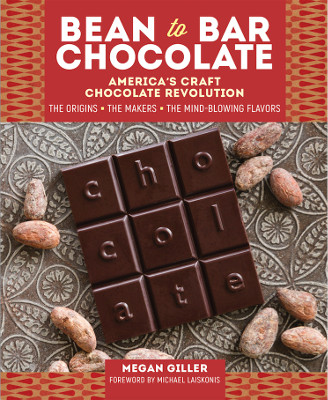
Bean to Bar Chocolate by Megan Giller
I have had chocolate in a number of forms and locations ranging from exotic and improbable such as a safari lodge and mundane such as my kitchen. I have sampled supermarket milk chocolate bars and dark chocolate gourmet bars, foreign and domestic. Over the years my preference has migrated from garden variety milk chocolate to the more flavorful options offered by specialty brands and artisan vendors. For some time I have been a fan of single origin chocolate bars, especially the plain dark chocolate ones layered with flavors.
My most recent chocolate experiences were enhanced manifold by Bean to Bar Chocolate America’s Craft Chocolate Revolution (Storey Publishing, $19.95), a new book by Megan Giller. Thanks to her detailed descriptions, I became much more aware of the diversity of the domestic craft chocolate movement and dozens of bean to bar makers. The 231-page hardcover book published this year features color photos, color illustrations and chocolate recipes.
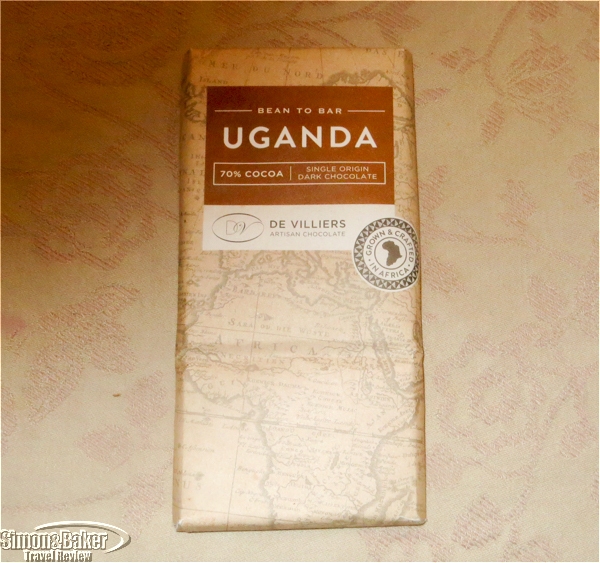
Bean to Bar chocolate from Uganda grown and crafted in Africa
My favorite part of reading her book was the gourmet experiences that followed from preparing her recipe for Water-Based Drinking Chocolate (from Aubrey Lindley, co-owner, Cacao). I also tried the Cocoa Tea (from Miss Choco) made with roasted nibs and water, although that was less to my liking. Once I procured the chocolate bars the Water-Based Drinking Chocolate was a cinch. Like the Cocoa Tea the recipe calls for only two ingredients, chocolate (or roasted nibs) and boiling water.
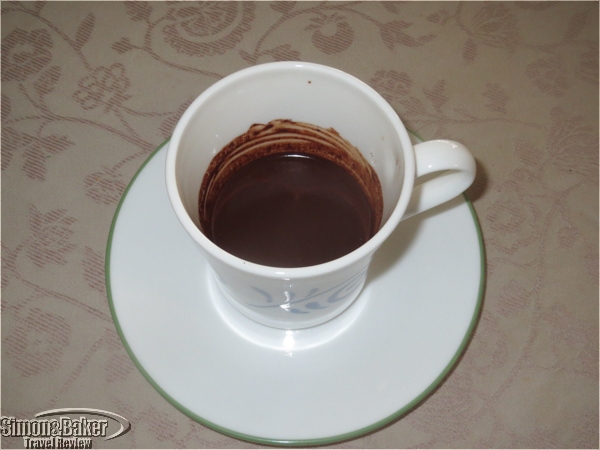
A few ounces of chocolate melted in a little hot water highlighted the qualities of each type we tasted.
For the Water-Based Drinking Chocolate we sampled four chocolate bar varieties, an organic and sustainably produced bar purchased at the supermarket; a bean to bar 70 percent single origin from Uganda made by De Villiers Artisan Chocolate near Paarl, South Africa; and a half and half blend (all we had available were partial bars) of single origin bean to bar Honduras The Lost City 72 percent and Dominican Republic Duarte 70 percent from Castronovo Chocolate from Stuart, Florida.
The beverage made with the supermarket bar was so awful we threw it out without finishing the serving. The Ugandan beverage tasted better although it was lumpy and had a medium to mild flavor, nothing extraordinary. The texture, even after whipping it twice with a small whisk, was lumpy. In defense of the makers it was past its expiration date. It was a good thing that we first tried the recipe with the Castronovo chocolates because we might not have sampled further otherwise.

The Castronovo chocolate bars were our favorites for the chocolate beverage.
The Castronovo blend was delightful, dark and rich with a hint of smokiness and flavors that lingered on the palate. Later, I bought more of the Dominican Republic Duarte, my favorite of the two available at the small shop where I purchased them, planning another Water-Based Drinking Chocolate made with those bars. Also, I want to sample more domestic bean to bar chocolates and plan tastings, maybe even try some of the other recipes in the book.
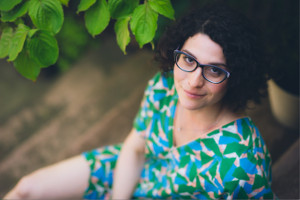
Megan Giller, author, Bean to Bar Chocolate
Giller, a Brooklyn resident, is a food writer, specializing in New York City and Austin, Texas. She writes Chocolate Noise, a blog. Giller’s chocolate knowledge shines throughout the book and her enthusiasm is contagious. She shares information on the craft movement, the people behind the chocolates from the farms to the makers and their approach to purchasing cacao beans, roasting, processing and making mostly single origin chocolate, mainly with only a limited number of ingredients. She also addresses history, equipment, labels, sustainable practices and pricing. There is a list of her favorite bean to bar makers in the back of the book.
*Book photos: Storey Publishing
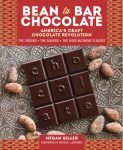 Click to buy Bean-to-Bar Chocolate
Click to buy Bean-to-Bar Chocolate
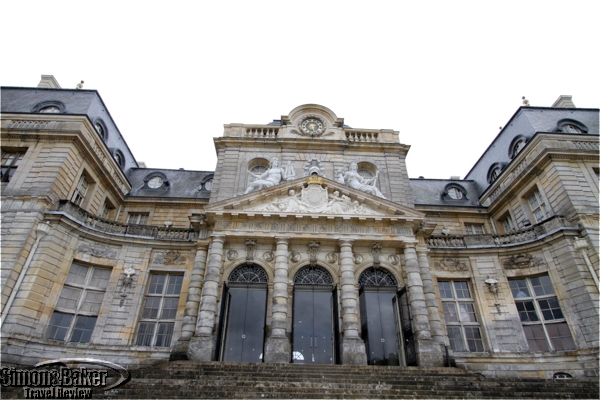
by Editor | Mar 6, 2017 | Attractions, Food, Luxury Travel, Spas
By Elena del Valle
Photos by Gary Cox
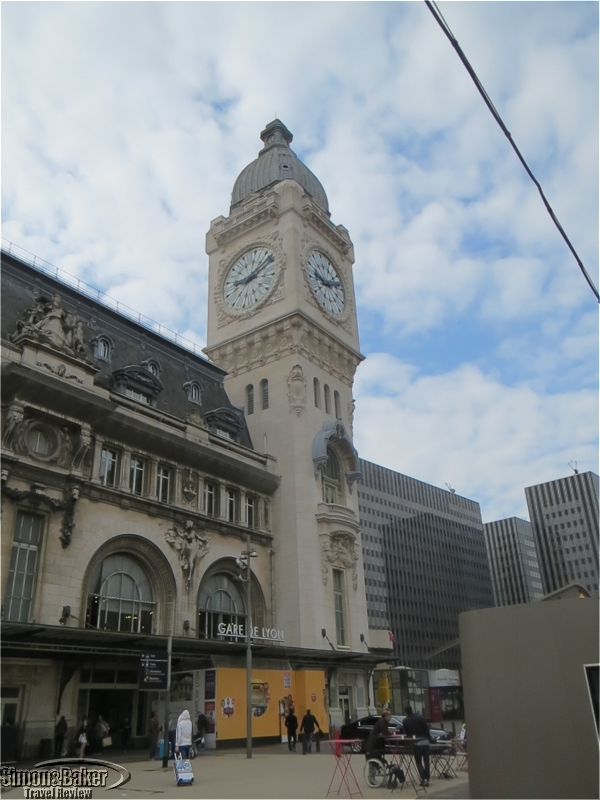
The Gare de Lyon train station in Paris
During a spring visit to Paris, France we went on an overnight side trip to the Seine-et-Marne Department (www.turisme77.co.uk and www.paris-whatelse.com) for the first time. To get there we took a train from the Gare de Lyon in the twelfth arrondissement of Paris to Melun, a city in the Seine-et-Marne. From there we made our way around by car from the train station to the area villages where, despite cold and rainy weather, we explored museums, chateaux, an artist village, a spa, and a pastry shop, spending the night at the La Demeure du Parc, a four-star boutique hotel within walking distance from the Château de Fontainebleau (Fontainebleau Castle), a museum and former royal residence.
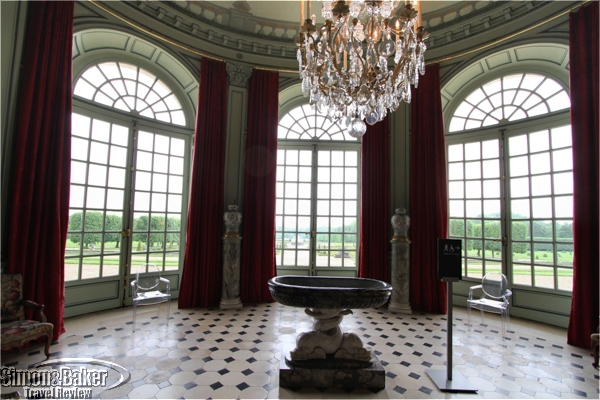
The rotunda inside the Château de Champs-sur-Marne looking out on the gardens
Our first stop was the Château de Champs-sur-Marne (see Eighteenth century home museum near Paris worth visit when in Seine-et-Marne area), a 16 room two story structure completed in 1708. Known for its rococo style and its Notable Gardens the former family home had been converted into a museum managed by the French government. After a guided tour in English of the Château de Champs-sur-Marne, we had lunch and a short guided tour in English of the Château de Vaux-le-Vicomte, a private estate open to visitors and my favorite attraction overall. Even when compared with grand former royal residences the property’s historic character, artistic harmony and beauty stood out. Before leaving and despite the ugly weather we made our way around the beautiful gardens in an abbreviated self-guided exploration.
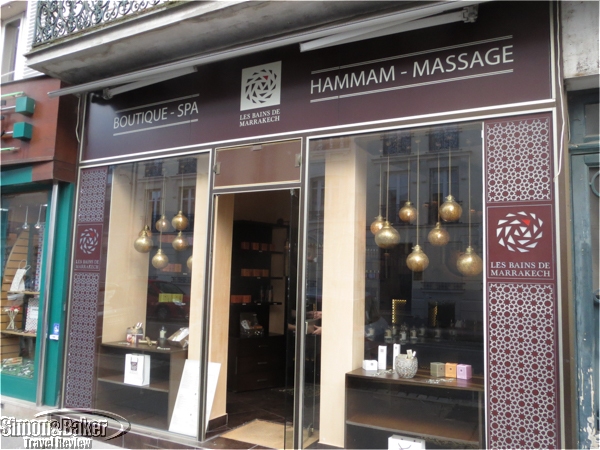
Les Bains de Marrakesh in Fontainebleau
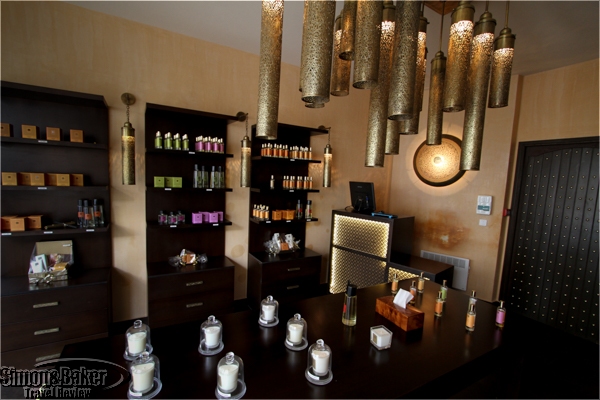
The shop at Les Bains de Marrakesh
Before checking into our hotel we had a massage at Les Bains de Marrakech (186 rue Grande, 77300 Fontainebleau, +33 09 81 13 17 21, lesbainsdemarrakech.com, fontainebleau@lesbainsdemarrakech.com). Because we arrived late our massages were cut short. Despite that the staff members were friendly and welcoming. The small facility was spotless and quiet.
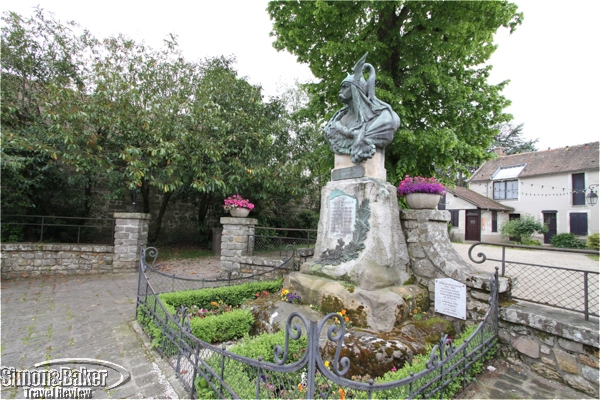
The war memorial in Barbizon
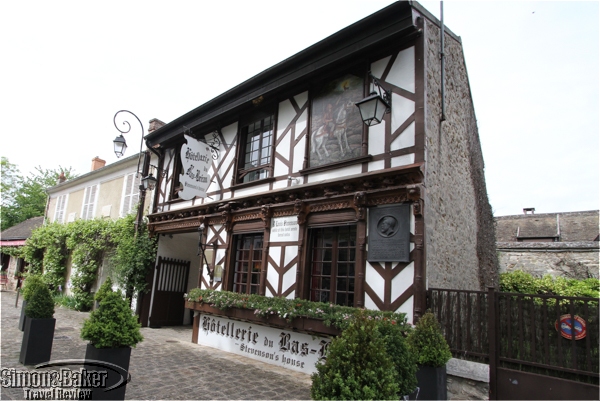
The house of Robert Louis Stevenson
Dinner (and breakfast the following morning) at our hotel was excellent. In the morning, we met Véronique Villalba, our English speaking guide in front of the Fontainebleau Castle, a former residence of the French monarchy, for an excellent tour. Following lunch, we headed to the charming artist Village of Barbizon, about seven miles northwest from Fontainebleau. We walked around with umbrellas in hand, exploring the touristy main street and admiring the pretty facades. We popped into Le Musee des Peintres de Barbizon (the Museum of Painters of Barbizon). Although it was crowded at times we enjoyed our visit thanks to our guide’s insights and engaging discussion.
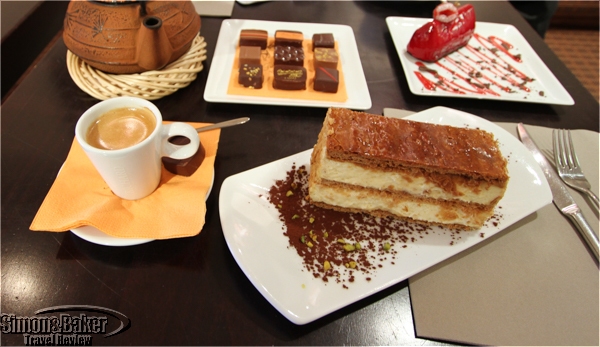
Tasty treats at Frédéric Cassel, Fontainebleau
On our way back to our hotel we stopped at Frédéric Cassel Fontainebleau (71-73, rue des Sablons, 77300 Fontainebleau, +33 01 60 71 00 64, www.fredericcassel.com), a shop in the town’s popular pedestrian shopping street for espresso, tea, chocolates, and pastries. We had a Vanilla Millefeuille and an Ilanka pastry, a worthwhile sweet ending to our pleasant visit, before our taxi drove us back to the small train station, where we boarded the crowded train back to Paris.
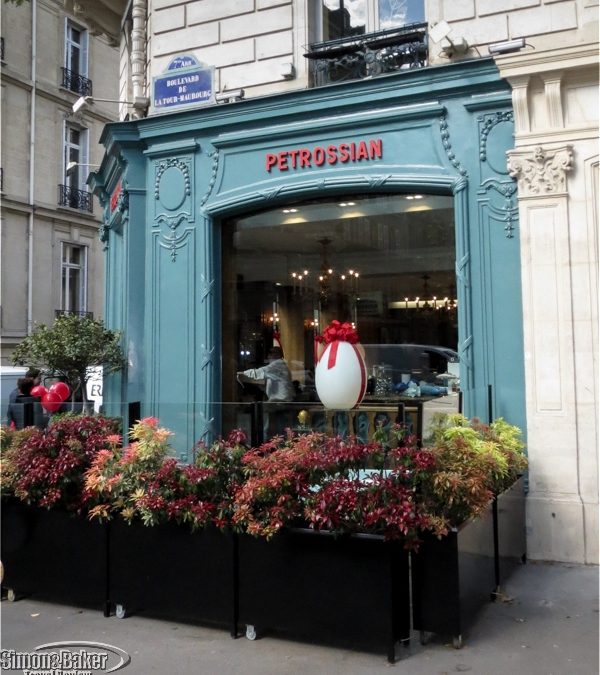
by Editor | Nov 27, 2016 | Food, Luxury Travel, Restaurants and Food
Article by Elena del Valle
Photos by Gary Cox
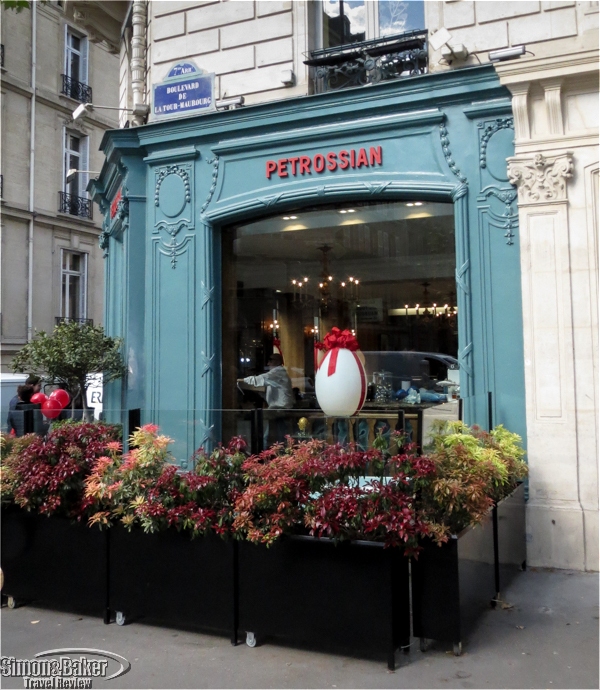
The Petrossian shop window on Boulevard de la Tour-Maubourg
Ever hear of Daurenki Impérial, Baika Impérial, Ossetra Impérial, Alverta Impérial, and Beluga Impérial? If you are a foodie you may already have an idea of what the names are, the types of farmed caviar some of which we tasted at the popular Petrossian Latour boutique in Paris, France owned by Armen Petrossian (18 boulevard de la tour Maubourg 75007 Paris, + 33 14 411 32 22, www.petrossian.fr, boutique@petrossian.fr).

Philippe Vanlacker described the types of caviar before we tasted them
On a cloudy spring morning we made our way, braving streets filled with protesters and police, to the Petrossian shop in the city’s Latin Quarter, where we sampled various products. Philippe Vanlacker, a friendly English speaking staff person, welcomed us and facilitated the caviar, Royal Salmon, and Kamtchatka Crab tasting. We liked that the only added ingredient was sea salt. There were no preservatives or additives, according to a spokesperson.
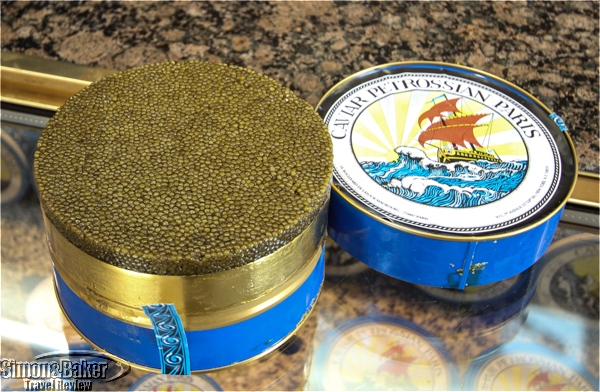
A kilogram of fine caviar
The caviar we tried, made from fish eggs and sea salt only, came from China, France, Israel, United States, and Bulgaria. The farmed salmon was from Scotland and the crab, previously frozen, was from Russia. The shop, about 600 square feet in size and staffed by eight people, appeared to be mostly for takeout purchases although it also had a few tables and a limited menu for customers wishing to have a light dish onsite. Our entire tasting was conducted while we stood facing the waist high counters without beverages of any kind.
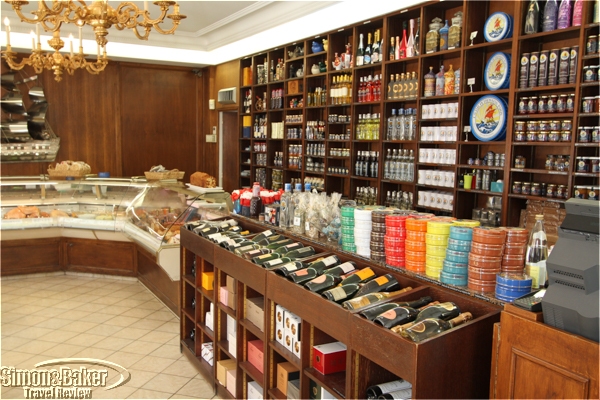
The interior of the shop
When we asked about the advantages of a store tasting a spokesperson explained by email, “When somedy (somebody) bring caviar home, it means that the man or the woman wants to seduce his/her partner or guest. But most of the time, he/she doesn’t know if they will like it. When they taste in the boutique, the can choose the caviar they have prefered (preferred) because they can taste differents (different) caviars. This is the big difference between internet, the others caviar houses and Petrossian: it’s the only place where you can taste the caviar before buying it.”
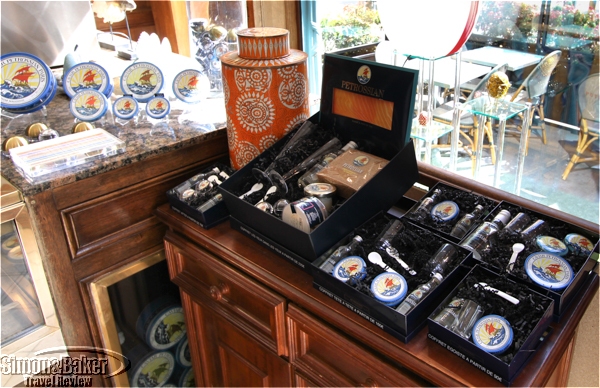
There were gift packages to accompany the caviar
Established in 1920 the shop draws local and international visitors the staff explained, saying that many people visit the boutique like a museum and stop to take photos. Some of the staff, including Joseph, Lorna and the owners, have been there for more than 30 years. Everything in the boutique is homemade and fresh, a spokesperson explained by email, adding, “Tourist come from all around the world because they know Petrossian. They want to bring back home a little souvenir, a little gift, and most of the time, they choose caviar because we offer them a cool bag with dry ice inside and they can travel with it.”
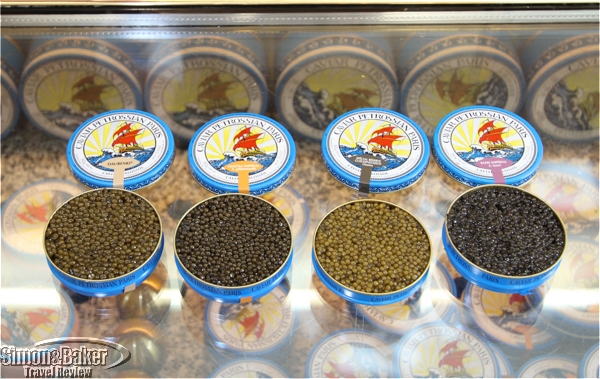
The staff person selected a single bite for our tasting from four caviar varieties sold in the metal containers pictured above
We liked the opportunity to sample the delicate products with the guidance of experts so that the caviar we tasted was at just the right temperature and optimum conditions. Too warm and the flavor is spoiled, too cold and it fades, the shop employee explained. The ideal temperature to taste caviar is between 6 and 8 degrees Celsius, he said. Being able to compare and contrast the nuances from one type of caviar to the other was an added advantage as it allowed us to form an opinion from the single tasting serving without having to purchase and prepare a tasting at home.
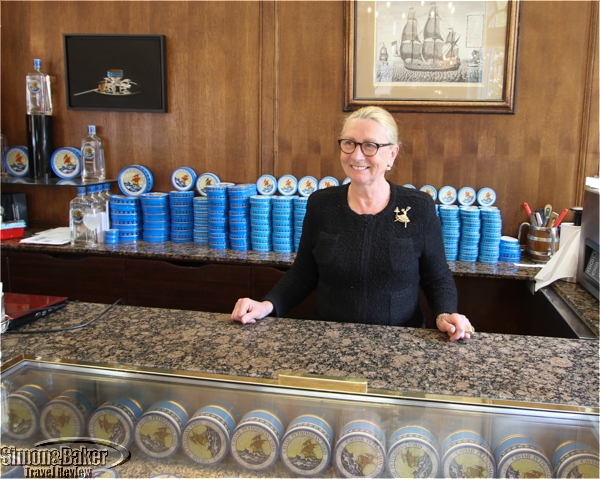
Cécile Petrossian supervised the tasting
We began the gourmet experience, under the supervision of Cécile Petrossian, Armen Petrossian’s gracious and elegantly attired wife, with caviar. While we watched our host pulled out tins from the glass counter before us, explaining the basics about the caviar, which was between eight and twelve months old. He used a special key to open the large cans such as a two kilo Ossetra Reserve container filled with plump sturgeon eggs he showed us before retrieving our sample from a small tin. Philippe handed each of us one serving of several types of fish eggs on disposable wood sticks, explaining wood and mother of pearl are commonly used to avoid distorting the delicate flavor with metal spoons. We were surprised at the slight variations in color, texture and taste of the caviar samples, light and smooth yet each with a distinct characteristic. One was dark, almost black with a hint of fish and salt. The Ossetra Reserve was dark gold and more defined. The Ossetra Impérial eggs were firmer than the Ossetra Reserve with a more pronounced flavor. And the final sample, also with a gold hue, reminded me of the sea yet had a fattier yet subtle taste.
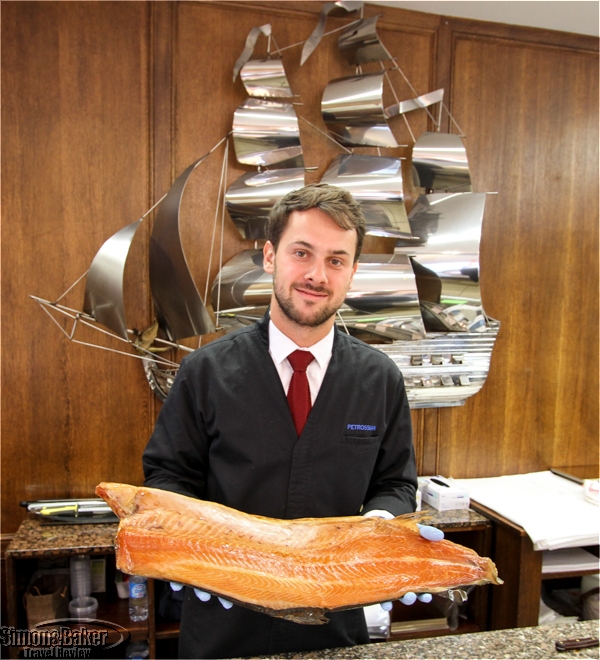
Phillipe displayed a smoked salmon chunk before slicing a sliver for our tasting
At the conclusion of the caviar sampling, we crossed to the opposite end of the shop to the salmon counter, where we sampled several flavors such as Caucasienne, Nature, and Bettrave. All were buttery in texture and seemed to melt in the mouth. Philippe explained their salmon was smoked and aged hanging so the excess fat could drip naturally and allow the remaining flavor enhancing fat to cling to the fish, lending it a rich yet understated taste and texture. We sampled the salmon “tenderloin” in three flavors. The Nature salmon was just that natural. The Caucasienne was prepared with a rub of 12 spices. And the Bettrave was colored with beetroot juice, which made it look like raw tuna. To crown the experience Philippe handed us a bite of Kamtchatka Crab followed by a dollop of the house tarama (fish egg spread).
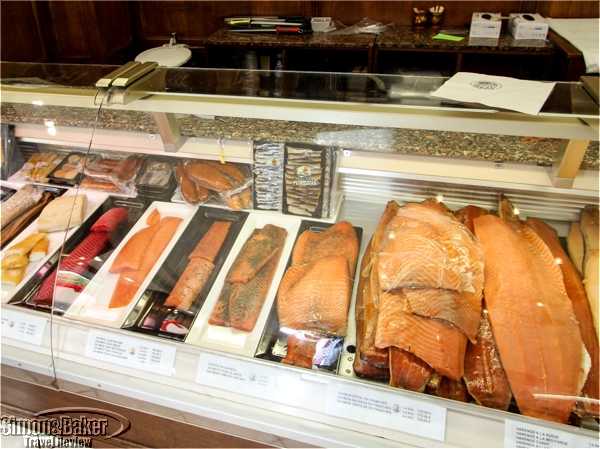
Several varieties of salmon, some with special marinades like beet root

There were prepared specialty foods
We liked the shop’s caviar and salmon selection and expertise and will recommend it to friends wishing to taste the specialty foods in a gourmet environment. The staff’s warm service in English enhanced the experience and would draw us back easily.
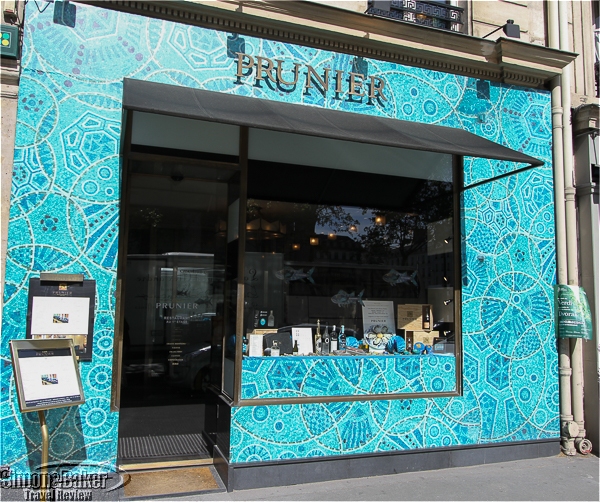
by Editor | Jul 25, 2016 | Food
By Elena del Valle
Photos by Gary Cox

The eye catching Prunier facade
For caviar and salmon newbies Boutique Prunier Madeleine (15 place de la Madeleine, 75008 Paris, France, +33(0)1 47 42 98 98, www.prunier.com/boutique, info@prunier.com), a Paris, France seller of farmed caviar and salmon among other gourmet delicacies, offered a low risk tasting. On our most recent visit to the City of Lights we went to the shop’s Place de la Madeleine location to try it. The first thing I noticed before even entering the 40 square meter shop established in 2006 was its eye catching bright blue tile facade. Although there were several gourmet shops in a row on the same street it was the Prunier window where I saw pedestrians browsing.
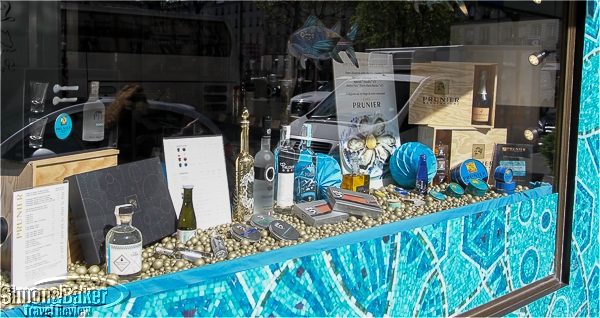
The window displayed vodka, salmon, caviar and champagne products
On the day of our appointment, Douchka Papierski, manager, Boutique Prunier, welcomed us with a sunny smile to match the spring weather. She led us to the Maturation Room, a refrigerated space with three glass walls facing the shop entrance. It was in that room where the caviar used to be stored in the past, she explained as we glanced around at the dozens of empty caviar tins that decorated the back wall. In front of us Douchka had set up two mother of pearl caviar spoons atop ice, two single morsels of the house salmon, and two shot glasses with a splash of clear liquid, one for each of us.
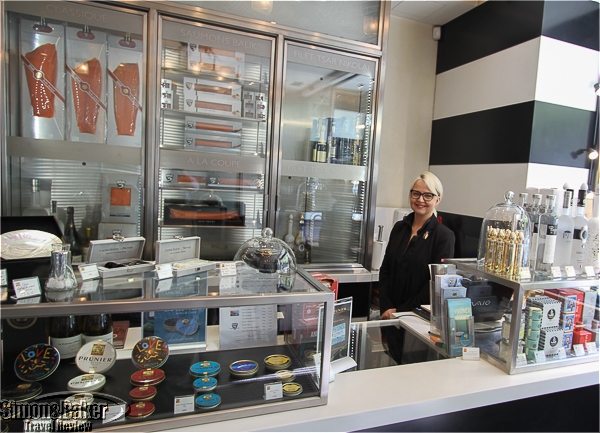
Douchka Papierski greeted us at the shop
We each had a single serving of 5 grams of Caviar Prunier Tradition, which she had prepared in advance of our arrival. She chose mother of pearl spoons because, she explained, metal spoons affect the delicate flavor of the caviar. For those who don’t own mother of pearl spoons 22 karat gold and plastic, neither of which alters the delicate flavor of the fish eggs, spoons will work just as nicely, according to her.
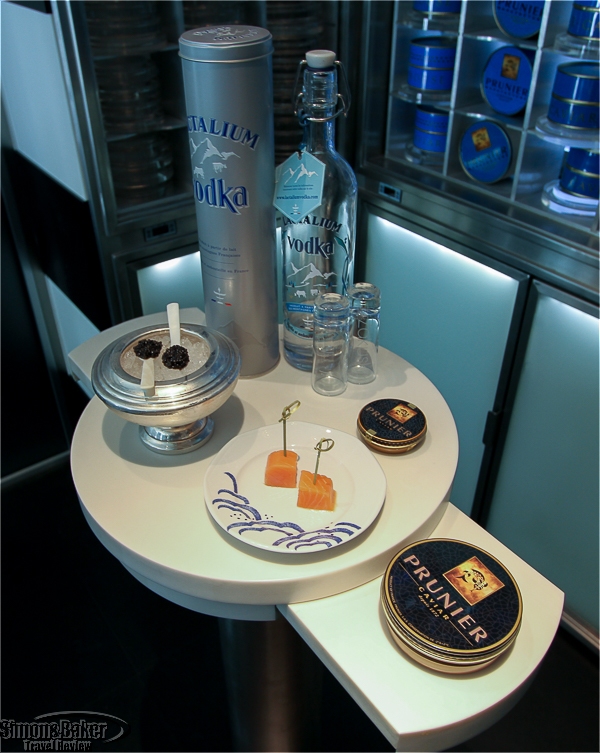
Our tasting was in the chilled room where they used to age the caviar
We began with the caviar. As soon as I placed the minuscule fish eggs, from a farm in the Dordogne region of France, in my mouth they melted. The flavor was mild and the texture buttery. It didn’t linger long.
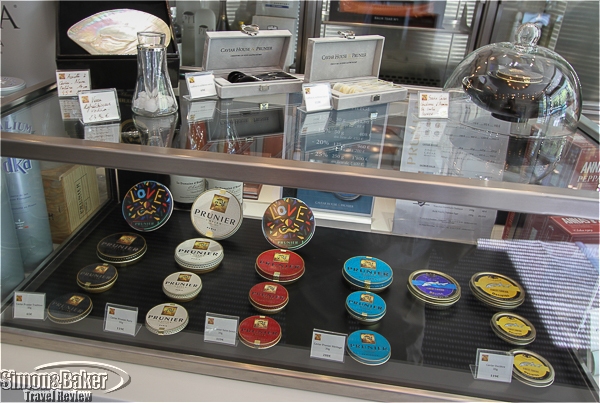
The display case shows the varieties of caviar available
Moments later we each tasted the Balik Tsar Filet salmon cube, farmed in Norway and smoked in the Swiss Alps. It too had a mild almost sweet taste and even more buttery texture than the caviar. As with the caviar it seemed easy to eat and we liked it.
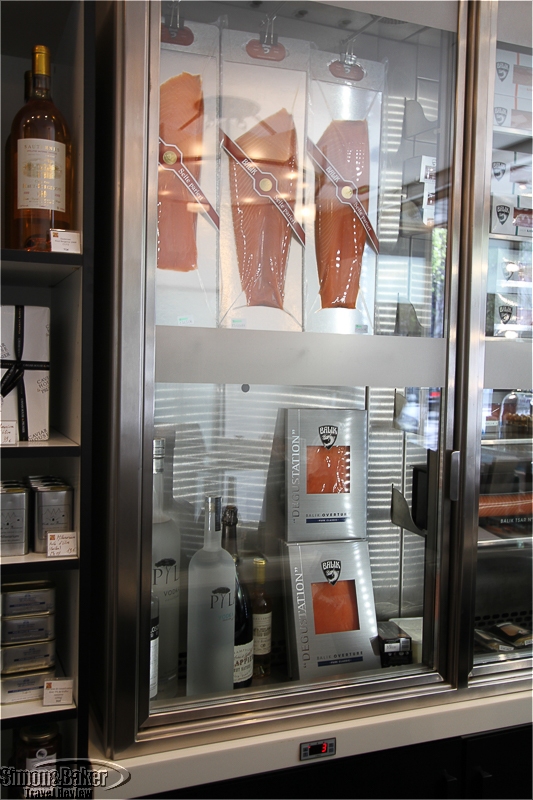
One of the shop’s refrigerators had Balik Salmon in several sizes
Next, Douchka described the single serving in the glasses as she introduced us to Lactalium, an artisan vodka made from milk from the Auvergne region of France. The nose was unlike any vodka I had sampled before. We each tasted the transparent liquid in our glasses. Perhaps because the smell was so distinctive I was it tasted like vodka. As we walked out of the refrigerated tasting area I wondered if the vodka would taste different with the caviar or the salmon or if the delicacies would have been enhanced by the vodka.
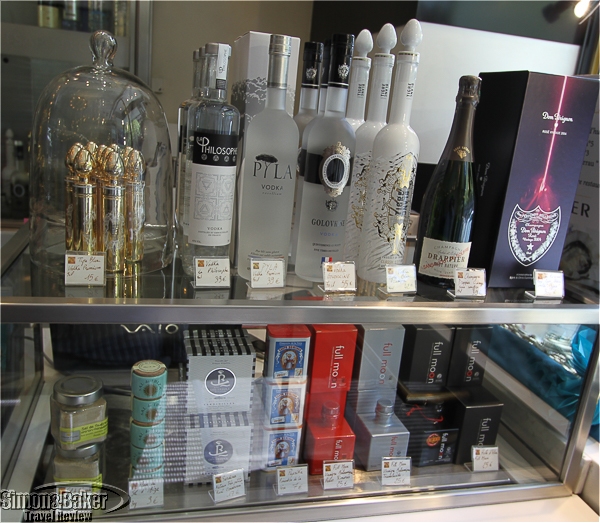
Another display case at the shop
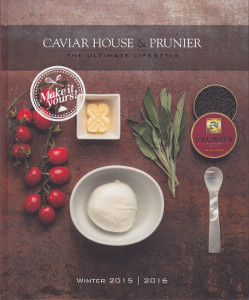
Caviar House and Prunier recipes
The price of the tasting we had, a single serving each of caviar (5 grams) and a similar amount of salmon, was 20 euros per person. The vodka was optional and complimentary “depending on the people, time they have, where they from and what’s new at the shop to discover and introduce to clients just like this special vodka of milk,” our host explained. As we left she gifted us a copy of Caviar House & Prunier Winter 2015/2016, an intriguing 63-page hardcover color cookbook with caviar, salmon and foie gras photos and recipes from chefs Mauro Elli and Chery Rohner.
by Editor | Mar 28, 2016 | Books, Food, Luxury Travel
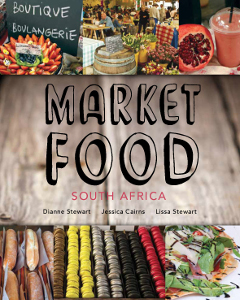
Market Food: South Africa
Following the explosion of local markets and the emergence of talented foodie entrepreneurs, Dianne Stewart and her two daughters, Lissa Stewart and Jessica Cairns, felt driven to travel around South Africa in search of the best market food. Two years later, in 2015, they published Market Food: South Africa (Bookstorm), a 167-page softcover book for tourists and locals. The book is divided into six sections: Find Your Local Market, Market Tastes, Market Meals, A Little Extra, Sweet Sensations, and Thirst Quenchers.
“Having experienced numerous food markets abroad, we knew that the world-class South African food markets were worth promoting,” Jessica Cairns said via email. “We visited markets nationally, in search of markets with their own unique personality and we sort after talented food vendors who were producing creative food of a very high quality. Market Food includes a directory of markets that we visited around the country and a diverse assortment of great market food recipes accompanied by the foodie entrepreneur’s unique stories. The book aims to promote the food markets and these talented vendors.”
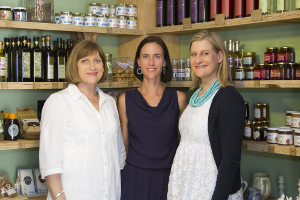
Dianne Stewart, Lissa Stewart and Jessica Cairns, authors, Market Food
Their favorite part of the project Cairns said by email was, “Eating our way around the markets! Sampling the delicious food, chatting to the vendors to get the background to their food and how they ended up at the markets. Dianne and Jessica collated the vendors recipes and retold the vendor’s personal stories while Lissa had the task of capturing the market atmosphere and the delicious food through the photographic lens.”
The biggest surprise? “The depth of the talent at these markets and the diverse personalities of each market- some tucked away in bustling harbour precincts, others on lush wine estates, in parks or inner-city warehouses,” Cairns said.
The three continue the promotion of food markets and talented food vendors on their website and social media channels (marketscoop.co.za) where they feature an updated national market directory (each market has its own page with photographs, maps and opening times), scoops of what is happening at markets around the country and the personal stories of some of the vendors they meet at the markets. Dianne Stewart is author of 30 books, Jessica Cairns is a former international banker, and Lissa Stewart is a food photographer.
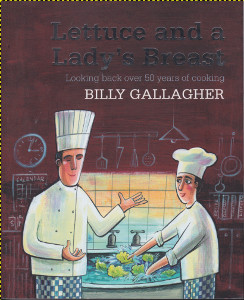
Lettuce and a Lady’s Breast
In Lettuce and a Lady’s Breast Looking back over 50 years of cooking Billy Gallagher (Billy Gallagher and Associates) outlines the highlights of his culinary life from his roots in the United Kingdom to South Africa. He shares insights from his personal life, his life as a chef as well as his work with the South African Chefs Association (SACA) and the World Association of Chefs Societies (WACS). The 330-page softcover book, published in 2015, is divided chronologically. It is peppered liberally with black and white and color images and photos.
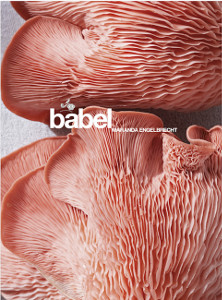
Babel Cookbook
Babel (Babylonstoren) by Maranda Engelbrecht is a 237-page softcover oversize book published in 2013. The visually appealing book has full color photos of the produce and meals from Babel, its namesake restaurant located within Babylonstoren, a relatively new produce farm lovingly established and nurtured in a former cattle farm, in South Africa’s Winelands region near Cape Town.

Maranda Engelbrecht, author, Babel
The self described food stylist’s affection for presentation is evident in the page size photos of plants and dishes served at the restaurant as well as the restaurant itself. Many of items on the restaurant menu are routinely made from products grown on the farm and its environs. The book is available for sale at a large shop on the farm.
Photos courtesy of Dianne Stewart, Lissa Stewart, Jessica Cairns and Babel
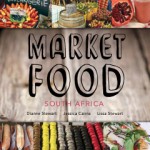
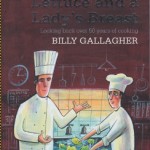 Click to buy Market Food: South Africa
Click to buy Market Food: South Africa and Lettuce and a Lady’s Breast
and Lettuce and a Lady’s Breast
by Editor | Oct 12, 2015 | Food, Luxury Travel
By Elena del Valle
Photos by Gary Cox
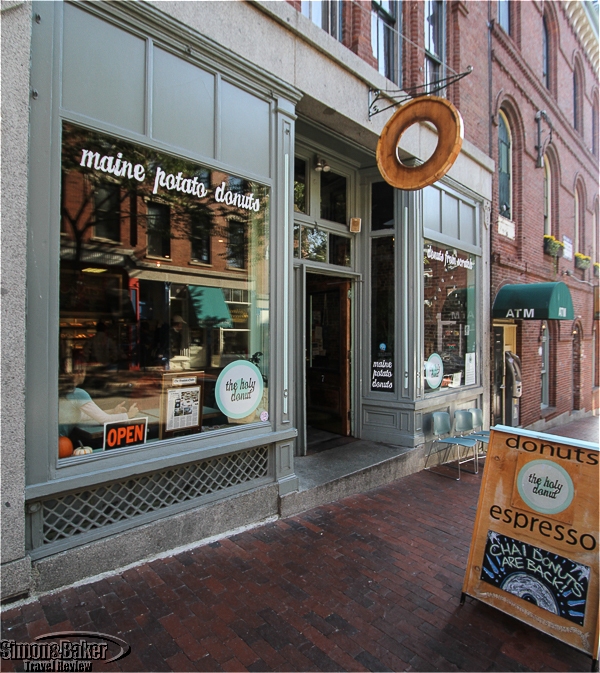
The front entrance to the Holy Donut
As soon as we heard about The Holy Donut (194 Park Ave and 7 Exchange Street, Portland, Maine, +1 207 874-7774, www.theholydonut.com, holydonutorders@gmail.com) from a local foodie we were intrigued. Established by co-owners Leigh Kellis and her father Allan Kellis the popular eatery in the heart of Portland, Maine made potato doughnuts from scratch.
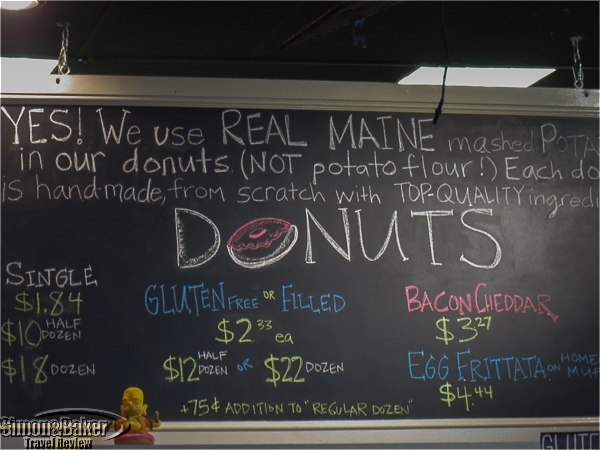
The board with the daily specials
The busy shop we visited on Exchange Street sold a variety of donuts made the old fashioned way from hand-cut Maine ingredients and potatoes. They rotated 16 flavors daily. They included Maine Potato with Pure Vanilla Glaze, Maple, Pomegranate, Fresh Lemon (hand squeezed and lemon zest), Real Mojito (fresh mint and lime zest), Allen’s Coffee Brandy (made with a Maine liquor), and Toasted Coconut with Coconut Milk Glaze.
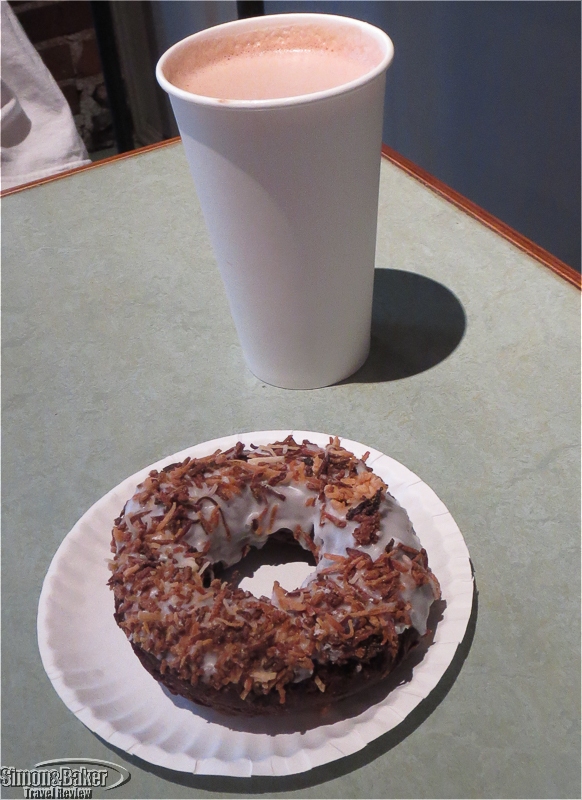
Our favorite donut and a hot chocolate
There was also Dark Chocolate with Pure Vanilla Glaze, Sea Salt, Cinnamon Sugar, and Toasted Coconut and Coconut Milk Glaze (our favorite from the few we sampled). There were also Sweet Potato donuts made with roasted sweet potatoes and Maine potatoes, Vegan, Gluten Free, Filled, and Bacon-Cheddar (another favorite). We can’t wait to go back to Portland to indulge in our favorites and sample new flavors.



















































